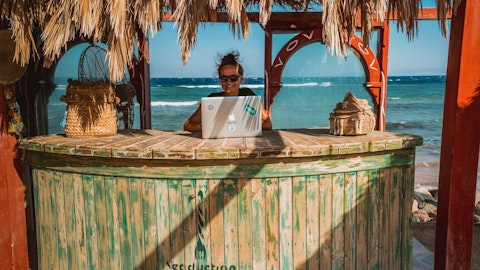And programmatic was excellent. We mentioned this in the letter. But we think our CPMs are growing more than the market, and that’s a combination of, again, technology and performance. And performance marketing, which has been a real source of strength throughout the year is – continues to do well. And the one thing I want to add on performance marketing is in this area, performance — where we’re delivering performance marketing, the product that we’re creating is something that our users really want from us. Users really want to hear from food and wine on what is the best air fryer. And we delivered that. We deliver that unbiased. We deliver that with real work put into the product. And then that also happens to monetize well, because it delivers performance marketing.
But you do that across all the Dotdash Meredith brands, and there’s a huge opportunity there. And I think, we’ve done a really good job. That was sort of central to the acquisition thesis with Meredith, and I think we’ve done a really good job executing against that, and it’s shown up a lot over the course of 2023.
Christopher Halpin: Thanks, Joey. For ’24, John, how we would think about overall trends in phasing is we expect digital revenue to continue to grow for all the factors that Joey articulated, while print revenues will continue to decline. Digital traffic and monetization have continued their momentum into the first quarter of ’24. The Ad market is fine, not great, not bad. And we think we’re taking share. We definitely think we’re taking share on traffic and also on some on revenue per session. So for the year, we’d expect 10% plus digital growth across ’24. Conversely, print revenues declined 12% in Q4 of ’23, and we’d expect similar declines next year. Especially in the first half, may slow down a bit in terms of decline in the second half.
When you look at our profitability. Our guidance is $280 million to $300 million in adjusted EBITDA across all of Dotdash for the year versus $267 million in adjusted EBITDA in ’23. But there’s some layers to that. It implies 5% to 10% EBITDA growth. But what’s really happening is strong growth and margin expansion continuing in digital and then offset by some profitability declines, which is what we’d expect. We’ve said our aim is to have our print EBITDA offset our Corporate segment. But in ’23, print actually significantly outperformed corporate by $24 million. In this current fiscal year, we’d expect the two to be pretty much equal. So really, all of that $280 million to $300 million of adjusted EBITDA guidance for this coming year is digital EBITDA.
That pattern will be pronounced in the first quarter. We expect digital EBITDA to grow 40% plus year-over-year in the quarter. Print will be roughly breakeven on an adjusted EBITDA basis in the quarter. It’s seasonally the smallest revenue. And also, we’ve got some expense increases like postage flowing through. And then finally, corporate expense should be roughly equal in the $9 million range to what we saw in Q4. For those looking year-over-year, just remember, we had the $44 million lease impairment that flowed through in Q1 of ’23 in corporate. When you roll that up, adjusted EBITDA in aggregate will grow in Q1, but strong digital growth will be masked by declines in print. And then for the year, digital revenue should continue, as we said, at 10-plus growth.
You’ll see that margin scale, the incremental margins and the seasonal uplift. And we feel good about the momentum trend across the business. Your last question on free cash flow conversion across all of IAC, if I’m getting that right, we felt good about getting back to free cash flow generation. Last year, it’s been a major point of focus by Joey to all of us. And we expect our conversion to only improve in ’24, due to a couple of factors. One is aggregate EBITDA, as evidenced in our guidance, should be up even with the sale of Mosaic, led by DDM and Angi. CapEx should stay in the $70 million range. Last year, in that 15% conversion that you referenced, we purchased the land under our headquarters for $80 million. That’s obviously not recurring.
Interest – net interest expense should only improve with higher yield for the full year than we had in our cash last year. And then we’ve got $1.4 billion of NOLs, which is a substantial tax shield. So roll that all up and we would expect 50% plus of adjusted EBITDA, to convert into free cash flow in ’24, and look forward to continue to improve going forward. Thank you, operator. Next question.
Operator: The next question comes from Brian Fitzgerald with Wells Fargo. Please go ahead.
Brian Fitzgerald: Thanks. On Angi, thanks again for the comments on the shape of the year there. We wanted to ask more specifically on consumer demand. I think the service request decline was one of the steepest we’ve seen, since you’ve been prioritizing quality and profitability. Are you closing in on getting the customer acquisition engine where you want it and getting to scale that back up? Do you have line of sight for when that hits sometime in ’24?
Joey Levin: Sure, Brian. I would say not yet in terms of line of sight. We are making real progress. We are — and I’ll also just point out, and I think you said some layer of monetized transactions are doing better than the trend line in service requests, because we are doing a better job with stuff that monetizes well and matching that better with service professionals. So that service request decline, while steep, is not as steep to the business as it appears. But maybe it’s helpful to talk about some of the things that, we’re working on and how those impact the business. I mentioned before, and I’ll keep mentioning this, because it’s so important to the business, the service professional retention trends and, relatedly, the improvement in monetized transactions per SR.



